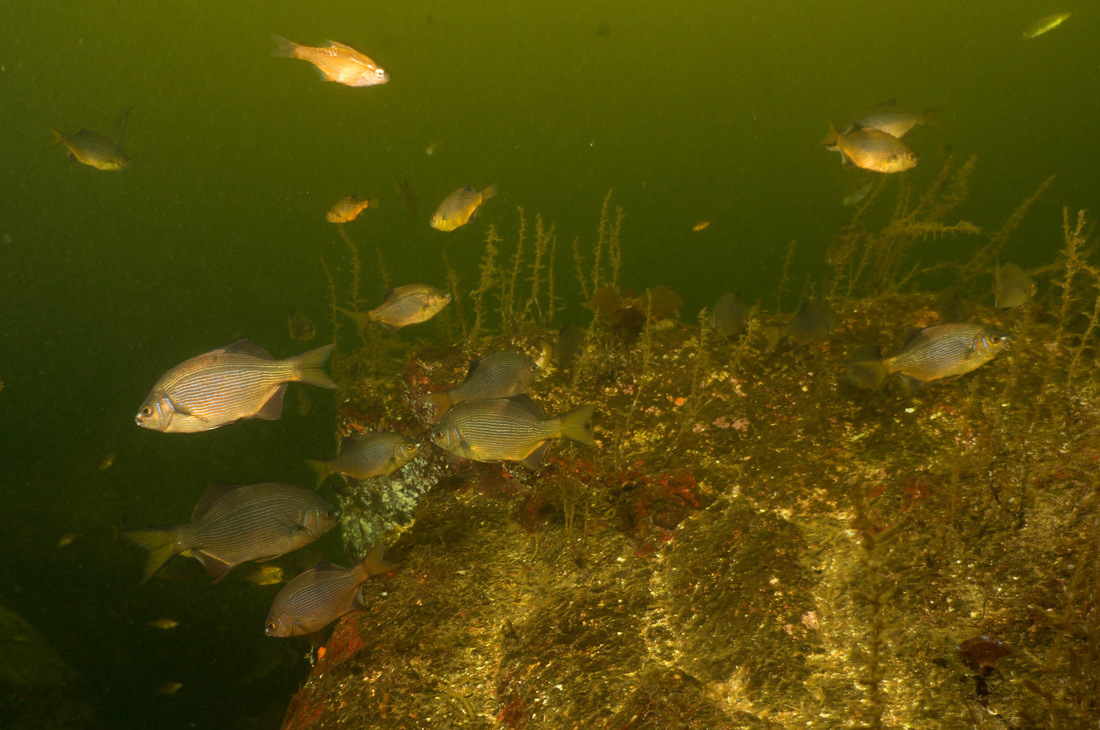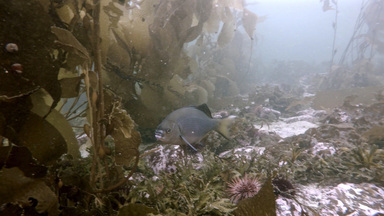Striped seaperch, blue seaperch, blue perch • Embiotoca lateralis
{Embiotoca = from the Greek works 'embios' meaning permanent, and 'tokos' meaning birth; lateralis = lateral, a reference to the horizontal blue stripes that distinguish this species}
Identification
The striped seaperch is one of the more colourful fish along the British Columbia coast. Its compressed, oval-shaped body is coppery with around 15 iridescent blue horizontal stripes below its lateral line, which arches up closer to the dorsal fin. Above the lateral line its back is coppery brown, as are its fins. Another identifying feature of this fish is the height contrast on its dorsal fin between the low front (spiny) portion and the taller back (rayed) portion, giving its dorsal fin the appearance of being swept back into a point. It also has a lighter spot in front of each eye.
The striped seaperch is one of the more colourful fish along the British Columbia coast. Its compressed, oval-shaped body is coppery with around 15 iridescent blue horizontal stripes below its lateral line, which arches up closer to the dorsal fin. Above the lateral line its back is coppery brown, as are its fins. Another identifying feature of this fish is the height contrast on its dorsal fin between the low front (spiny) portion and the taller back (rayed) portion, giving its dorsal fin the appearance of being swept back into a point. It also has a lighter spot in front of each eye.
|
Habitat & Range
This colourful fish can be found in kelp beds as well as in and around rocky reefs. It schools in shallow rocky areas and around docks and pilings, and is found in the subtidal to 50 m deep. Its range extends from southern Alaska to northern Mexico. Intriguing Info The striped seaperch eats worms, mussels, snails, and small crustaceans. This species is viviparous. |
References
Froese, R. and Luna, S. M. Embiotoca lateralis Agassiz, 1854 Striped seaperch. FishBase. Accessed 10/11/2015.
Lamb, A. and Edgell, P. Coastal Fishes of the Pacific Northwest. Revised. (2010). Madeira Park, BC: Harbour Publishing. P. 95-96.
Lamb, A., and Hanby, B. (2005). Marine Life of the Pacific Northwest [electronic version]. Madeira Park, BC: Harbour Publishing.
Authors and editors of page
Kelly Fretwell (2015).
Froese, R. and Luna, S. M. Embiotoca lateralis Agassiz, 1854 Striped seaperch. FishBase. Accessed 10/11/2015.
Lamb, A. and Edgell, P. Coastal Fishes of the Pacific Northwest. Revised. (2010). Madeira Park, BC: Harbour Publishing. P. 95-96.
Lamb, A., and Hanby, B. (2005). Marine Life of the Pacific Northwest [electronic version]. Madeira Park, BC: Harbour Publishing.
Authors and editors of page
Kelly Fretwell (2015).






